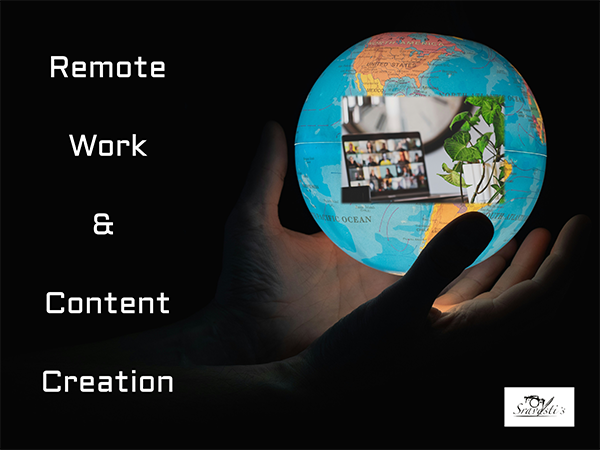Remote work and content creation have been prevalent since the late 1990s. As a consultant, I have been working remotely and creating content since 2005, utilising tools like emails, Skype, remote desktop solutions like Citrix and TeamViewer, online forums, project management tools, and mobile phones. The rise of Androids and iOS has revolutionised digital tools and remote work.
The widespread adoption of cloud-based platforms, advanced VC (video-conferencing) tools, and remote work policies in the 2010s further fuelled the growth of remote work. COVID-19 accelerated this trend as individuals and companies adapted to remote work to ensure connectivity and continuity. Over the past decade, the internet and digital media have become essential aspects of our daily lives and work.
How Remote Content Creation Works
Remote content creation involves utilising high-speed internet, communication tools and collaboration platforms to work with clients, team members and vendors from different locations. Content creators generate articles, videos, graphics, podcasts, and other forms of content through various ideation, development, and production processes. Work is done synchronously or independently, using digital and technological platforms to share ideas, provide feedback, and deliver content efficiently despite physical distances.
Key Aspects of Remote Work for Content Creators
- Flexible Work Environment: Remote content creators can work from any location, from their homes, shared workspaces or cafés, improving work-life balance and productivity. According to a survey by Buffer (State of Remote Work 2023), 22% of respondents stated that the foremost benefit of remote working is flexibility in how they spend their time.
- Digital Collaboration Tools: Remote teams use digital tools and online platforms like project management software, VC and instant messaging apps, and cloud-based storage solutions. These help in real-time communication, file sharing, task tracking and project management. The most robust tools for remote collaborative work are Adobe, MS Office, Slack, Webex, AnyDesk, Google Meet, and Zoom.
- Virtual Meetings and Brainstorming Sessions: Remote content creators hold virtual brainstorming sessions using audio or VC software. This allows team members to exchange ideas, provide inputs and make decisions collaboratively. It helps reduce time wasted in waiting for replies to emails and messages.
- Remote Editing and Review Processes: Content creation processes include multiple rounds of editing, revisions, and feedback. To ensure accuracy and quality in the final content deliverable, remote co-workers use online editing tools, version control systems, and shared documents to streamline the editing and reviewing processes.
Benefits of Remote Work
- Global Talent Pool: Adopting remote working options opens up a world of talent without additional cost. Companies can tap into a diverse talent pool of employees or consultants without the restrictions of geographical boundaries. Freelancers can work on global projects and receive online payments.
- Flexible Hours and Work-life Balance: Since various work elements can be scheduled at personal convenience, remote workers can improve work-life balance. They can put in more work hours as travel time is cut down. But, work can intrude into personal time and space, so efficient time management is imperative.
- Cost Savings: The biggest advantage is a significant cost reduction due to decreased overhead expenses like office rent, travel and utilities.
However, remote work in the content creation industry can be a double-edged sword. On one hand, flexibility can lead to creative challenges and generate new ideas. On the other, there are some hurdles that most remote workers experience.
Challenges of Remote Work
- Communication Breakdowns and Missed Deadlines: Misunderstanding tones and slow responses can hamper effective collaboration. This happens especially with members with weak language skills and moonlighters who prefer not to answer or adhere to deadlines while working on simultaneous projects. It may take longer to complete collaborative work. Ensure all team members are aligned and informed to maintain cohesion.
- Distractions Aplenty: It is easy to get sucked into non-work related activities while working from the comforts of home. The over-powering attractions of OTT, social media and the bed can be disruptive. For women, household chores are a significant distraction while working from home. Establish boundaries and create a dedicated workspace to minimise distractions.
- Lack of Team Bonding and Creativity: The synergy and bonding that typically occur through face-to-face interactions become challenging in remote work environments. Sometimes, a chat with a colleague at the coffee machine spurs a brilliant idea. Casual interactions in workplaces can increase creativity and innovation. Remote teams may need to be more intentional about fostering creativity.
- Loneliness: According to a survey by Buffer (State of Remote Work 2023), 23% of remote workers struggle with loneliness. Remote workers must be able to self-motivate.
Optimising Effective Collaboration
- Set Clear Expectations: Define goals, roles, work policies, ethics, deadlines, deliverables and communication channels from the beginning. This helps prevent misunderstandings and improves collaboration.
- Leverage Technology: Use cloud-based storage and applications with VC tools like Slack, Zoom, and Google Drive to reap the real benefits of remote working. Record meetings to the extent possible for future reference and request all participants to keep their cameras on during VCs. Promote the “bring your own collaboration” (BYOC) policy to improve productivity.
- Schedule Regular Check-ins: Stay connected through regular video calls, daily stand-ups, and team meetings. These provide opportunities to share updates and address challenges.
- Encourage Watercooler Talks: Not all team meetings need to be work-related. Set up virtual non-work-related chats, a dedicated Slack channel for memes or weekly Zoom happy hours to promote camaraderie that is otherwise missing in the online work world. Informal interactions positively impact job satisfaction and commitment.
Balancing benefits and challenges is crucial for successful remote content creation. Remote work has changed the way individuals and companies operate. And, most importantly, it is here to stay.
I am glad I started early and did not have to adapt to remote working overnight during the pandemic. If you are looking for experienced remote content creators, contact Sravasti’s now.
Photo Collage: https://www.photocollage.com/
Image: Sigmund, Greg Rosenke and Sravasti

